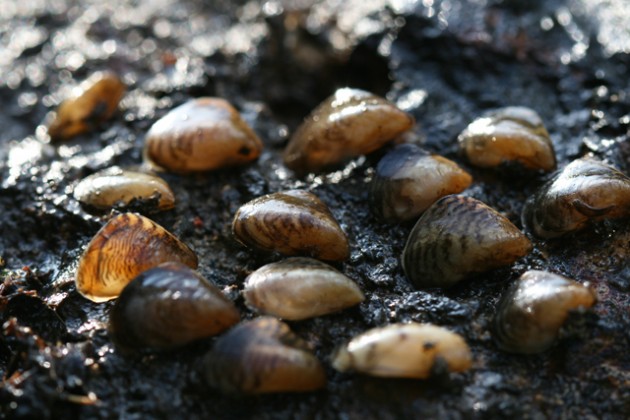The invasive specied can affect freshwater ecosystems, block water pipes and smother boats' hulls
Boaters are being urged to help stop the spread of an invasive species of mussel.
The Quagga mussel (Dreissena rostriformis bugensis) was first discovered by Environment Agency teams
carrying out routine water quality testing on River Wraysbury on the South East Coast of England.
It has subsequently been found
in the nearby Wraysbury reservoir.
The
identification was
confirmed by Dr David Aldridge of Cambridge University on 1 October 2014.
Since
the mussel was identified the Environment Agency has been working with partners
including Thames Water, Angling Trust and local angling clubs, to put
biosecurity measures in place.
Work is underway to monitor the River
Thames and reservoirs in the local area to investigate the extent of the
problem and the distance that the Quagga mussel has spread.
Anglers
and boaters can play an important part and everyone is urged to help stop the
spread of this species by following the ‘check, clean, dry’ approach and
thoroughly cleaning any equipment.
The Quagga mussel is a prolific breeder – a fully mature female mussel is capable
of producing up to one million eggs per year. Due to its ability to filter out
large quantities of nutrients and to breed quickly, the quagga mussel can
significantly reduce native populations and affect freshwater ecosystems.
It
can outcompete native mussels. This alters the ecology of the habitats it
invades.
It can also block water pipes and smother boats’ hulls.
Sarah
Chare, deputy director of fisheries and biodiversity at the Environment Agency,
said: ‘Invasive
species – such as the Quagga mussel – cost the UK economy in excess of £1.8billion every year. And while Britain’s rivers are the healthiest for over 20
years, rivers that harbour non-native species could fall short of tough EU
targets.
‘The Quagga mussel is a highly invasive non-native species, affecting water quality
and clogging up pipes. We are monitoring the extent of its spread and working
closely with partners to ensure they are aware of it.’
Quagga mussels are quite similar to zebra mussels, another invasive
species which is already widespread in England and Wales. They are small
with a dark brown and light brown stripy shell. They are more rounded
than a zebra mussel so when placed on its front it will roll to one
side. Quagga mussels also have an undulating (as opposed to a
straighter, horizontal) seam between the shells.
The
mussels tend to be about the size of a human thumbnail but can grow to about
4cm. The larvae of Quagga mussel are not visible to the naked eye, which makes
drying a critical step in applying good biosecurity.
There’s good evidence that
rinsing or soaking equipment in hot water increases the chance of killing
larvae and adults, and is a suggested addition to the Check, Clean, Dry
approach.
Jane Swan, The Green Blue project manager, said: ‘The Quagga mussel is a highly invasive non-native species. It can affect whole ecosystems by filtering out large quantities of nutrients. It also presents a serious biofouling risk by blocking pipes, smothering boat hulls and other structures.
‘Eradication of most invasive species once established outside their usual range is very difficult so the best approach to deal with arrival of new species is to focus on better biosecurity, especially the Check, Clean, Dry routine for both inland and coastal boating activities.’
What to do:
On the water
· When leaving an anchorage, wash off both the anchor and chain before stowing.
· Avoid sailing or motoring through water plants and weed if possible.
On land
· Check equipment and clothing for live organisms – particularly in areas that are damp or hard to inspect before moving them to a new location. The difficulty with the Quagga Mussel is that it produces abundant populations of microscopic (“veliger”) larvae which are invisible to the eye. So soaking equipment and clothing in hot water on site or when you return home as well, will improve the chances of killing larvae and adults.
· Clean all parts of the boat, trailer and equipment that come into contact with the water before leaving.
· When recovering a trailer, dinghy, PWC or RIB, drain water from every part of the boat and all equipment that can hold water.
Static submerged structures
· Any structures or equipment such as pontoons, piles and buoys which have been submerged in water for a time also pose a higher risk of spreading invasive species and so extra care should be taken when moving or working with them.
· For specific biosecurity guidance follow this link submerged structures.
If you think you may have found a quagga mussel, send an email with a photograph and location details to: alertnonnative@ceh.ac.uk
Picture: Wraysbury Quagga mussels. Credit: David Aldridge/Cambridge University




